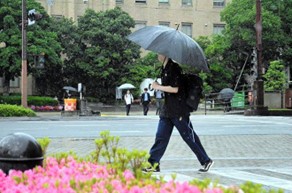The Japan Meteorological Agency (JMA) has officially announced a shift in seasonal weather patterns, marking the start of the rainy season in some southwestern regions and the end of it in Okinawa.
At 11 a.m. on Sunday, the agency confirmed that the rainy season has begun in northern Kyushu and Shikoku, two key areas in southwestern Japan. On the same day, it also declared the end of the rainy season in Okinawa, Japan’s southernmost prefecture.
A Closer Look at the Timing
This year, the start of the rainy season came four days later than average in northern Kyushu and three days later in Shikoku. However, when compared to last year, it actually began nine days earlier in both areas.
On the other hand, Okinawa’s rainy season ended earlier than usual, tying with the record set in 2015. This makes it the earliest end to the rainy season in Okinawa since the current format of weather records began.
Heavy Rainfall Already Making an Impact
Despite just starting, the rainy season has already brought heavy downpours to some parts of southern Kyushu. In Yakushima, a town in Kagoshima Prefecture, 53 millimeters of rain fell within one hour on Sunday morning. This type of intense, short-duration rain is likely to continue in various parts of northern and southern Kyushu.
The Japan Meteorological Agency is predicting up to 80 millimeters of rainfall in northern Kyushu and up to 120 millimeters in southern Kyushu over the next 24 hours (through Monday morning). This may increase to 150 millimeters in both areas by Tuesday morning.
Seasonal Rain Front to Stay Longer
The seasonal rain front—a weather system that causes Japan’s rainy season—is expected to hover over western and eastern Japan for a while, bringing continued rainfall.
Due to these conditions, the JMA has issued alerts and is urging residents in affected regions to:
- Be cautious of landslides
- Watch for flooding in low-lying areas
- Stay away from swollen rivers
People are also encouraged to check hazard maps, understand the risks around their homes and workplaces, and be familiar with local evacuation routes and shelters before rain becomes more intense.
What Is Japan’s Rainy Season?
Japan’s rainy season, known as “tsuyu”, usually occurs between early June and mid-July, depending on the region. It’s caused by the clash between warm, moist air from the south and cooler air from the north, leading to prolonged cloudy weather and significant rainfall.
While essential for agriculture, the rainy season also increases the risk of natural disasters, such as floods and landslides—especially in mountainous and low-lying areas.
Why It Matters
This year’s shifts in timing—both early and late starts and finishes—remind us of the unpredictability of climate patterns. Early preparation and constant awareness are crucial, particularly in areas like Kyushu and Shikoku, which are more vulnerable to heavy rains and related disasters.
Authorities continue to monitor the situation closely and are sharing real-time updates to help keep people safe.
FAQs
Q1: Why did the rainy season end so early in Okinawa?
Okinawa’s rainy season ended earlier than usual this year, likely due to a weaker seasonal rain front and stronger high-pressure systems moving in from the Pacific Ocean. These systems helped push the rain front away earlier than expected. In fact, this year ties with 2015 for the earliest rainy season end since records began using current methods.
Q2: What should residents do to stay safe during the rainy season?
Residents should take the following precautions:
- Stay informed through local weather reports and JMA announcements.
- Check hazard maps for landslide-prone or flood-risk areas around their homes.
- Prepare an emergency kit with essentials like water, food, flashlights, and medicines.
- Know the location of evacuation centers and routes.
- Avoid going near rivers, cliffs, or any area prone to landslides during heavy rain.
Final Thoughts
As Japan enters its rainy season, especially in northern Kyushu and Shikoku, it’s important to stay alert, be prepared, and follow weather advisories. While the rain is vital for replenishing water sources and supporting agriculture, it also comes with potential dangers. By staying informed and ready, residents can better protect themselves and their communities during this season. Stay safe, and remember—being prepared is the best way to weather any storm.
Source:https://www3.nhk.or.jp/nhkworld/en/news/20250608_10/












